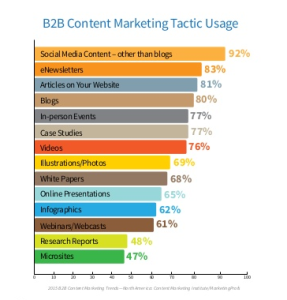The era in which we consider content marketing a specialized, separate function of the organization deserves to be closed. The reality is that all of marketing—particularly B2B—depends on content. It’s in the DNA.
If you’re in field marketing, you need content. If you’re in demand generation, you need content. If you’re in corporate communications, you need content. Just about every single tool, channel, and role relies on marketing content as fuel.
I’d wager most of you reading this know and agree with what I’m saying. It’s harder to know exactly which types of content to make.
Every year, the Content Marketing Institute conducts a survey of B2C and B2B marketers, learning about the content they make. With the longer, complex sales cycles typically involved in selling from one business to another, it makes sense that the types of content deployed shift from industry to industry.


But usage doesn’t mean it’s working. And I get asked all the time, “What types of content work best for this stage of buyer’s journey?”
The honest answer is, “It depends.” It depends on your industry, the content consumption habits of your buyers, the complexity of your product or service. There’s no one-size-fits-all approach.
But there are at least six kinds of content I’ve seen as invaluable to just about every B2B marketing organization. So I’m going to name the go-to content types for B2B, along with an explanation of why they’re so useful.
Webinars
There’s nothing that beats that live experience when it comes to generating leads, and more importantly, qualifying leads. Webinars are likely the most scalable type of content that delivers this live experience. When done right, webinars can be both compelling in demonstrating thought leadership and the viability of your product or service.
That’s not to say they’re cheap or easy. A good webinar takes forethought and planning, execution, and regular iteration on subject matter and delivery. But they’re also one of the most powerful content types out there for B2B.
Blogs
There’s been a lot of talk about blogs dying off. If usage is dropping off in your industry, thank your lucky stars. Because blogs remain one the most effective and fastest ways to get your message out and build an audience. There are a number of reasons why blogs fail. But if you account for these, a blog can become your best friend.
No surprise here. Marketers, from both the B2B and B2C sides of the house, regularly report positive value from their email marketing efforts.
But it’s not just the delivery mechanism that makes email so highly regarded in the overall marketing content mix. It’s the role it plays in lead nurturing. Modern marketing can’t just batch and blast anymore—not in a complex sales cycle. You need to earn and hold the attention of buyers, and that means crafting lots of emails that speak to their particular pain points, needs, and solutions.
Whitepapers
You’re not trying to sell sticks of gum. (Unless, of course, you’re trying to sell warehouses full of sticks of gum.) Chances are your product or service involves some level of complexity. And then the problems your industry faces are even more confusing to buyers.
Whitepapers break down this complexity into digestible chunks. This is often the point where you help the buyer put their finger straight onto the issue they can’t quite elucidate. And the more you can attach valuable research and data points, the better. eBooks might be the sexier cousin, but in B2B the whitepaper is still essential.
Infographics
Think of the infographic as the companion piece of the whitepaper. Only you’re taking all those insights and breaking them up into digestible, entertaining chunks.
Any top salesperson in B2B will tell you to lead conversations with an insight. Infographics are a compelling way to deliver these insights. While the market has become saturated with infographics, the right amount of creativity and actual data can still break through the clutter.
Case Studies
Here’s where I take the most liberty with a “content type.” A case study can come in the form of a blog, a video, a PDF…whatever. The important thing is that a customer is advocating, clearly and compellingly, on behalf of your product or service. In too many organizations, case studies are created in an entirely separate process from all that top of funnel content.
Really, testimonials and thought leadership should work in tandem, aligned to a common process and set of themes. That creates a seamless, designed path for buyers to follow. So make sure your case studies are built into your content plan.
This article was syndicated from Business 2 Community: 6 Types of Content B2B Marketing Can’t Thrive Without
More Sales & Marketing articles from Business 2 Community:




